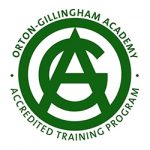What is Dyslexia?
Dyslexia is an unexpected difficulty mastering literacy skills such as reading, writing, spelling, expository writing and/or arithmetic. People with dyslexia have normal or better intelligence.
- Dyslexia is a neurological trait and most often is genetic in origin.
- It is NOT the result of “not trying”, or attention deficit disorder. However ADHD may be present.
- Dyslexia is NOT the result of social/emotional problems. However, social/emotional problems may result from frustration at school.
- People with dyslexia often have strengths in areas such as art, drama, sports, music, science, creative writing, mathematics, mechanics, computers and aviation.
- Many high achieving people are dyslexic – especially those who have had appropriate specialized instruction.
- Appropriate remedial skill teaching is effective at all ages.
- Dyslexia is included in the laws that cover special education: Individuals with Disabilities Education Improvement Act of 2004 Definition in Part A, General Provisions U.S.C. 1401. Definitions.
- The scientific definition of dyslexia may be found at the International Dyslexia Association/ National Institutes of Health Definition http://www.interdys.org/FactSheets.htm
Common Characteristics
- inaccurate reading
- poor spelling
- trouble “sounding out” words
- slow reading
- guessing on multisyllable words
- dislike of reading
- dislike of school
- reversals and/or transpositions of letters, syllables and/or numerals
- poor reading comprehension, especially in complex materials
- labored, hard to read handwriting
- trouble learning the alphabet and basic math facts
- trouble writing school papers
- difficulty organizing ideas and details to write and/or speak
- difficulty following directions
- disappointing test scores
- trouble learning grammar
- low self esteem
- relatives with similar problems
(Not all characteristics apply to every person – look for a cluster)
What is Orton-Gillingham?
Orton-Gillingham is an approach, not a method. This means the O-G practitioner is flexible in the use of materials and the sequence of instruction. Classic Orton-Gillingham is an alternative, research-based, reading, writing and spelling curriculum designed specifically for dyslexic readers and others struggling with literacy skills.
- Validated by scientific reading research sponsored by The National Institutes of Health and the National Academy of Sciences
- Systematic – synthetic phonics emphasizes the alphabetic principle; phonemic awareness; phoneme segmentation and blending; reading comprehension; and reading fluency
- Flexible and individualized – diagnostic/prescriptive teaching enables the tutor to adapt curricular elements to the needs of each student.
- Effective for all ages – a skilled Orton-Gillingham tutor can help students achieve their potential and succeed in general education classes from grade school through college.
- Success oriented – materials are presented in a direct instruction, multisensory format. Elements are introduced sequentially with cumulative review.
- Skill building – starting with basics, the student moves toward mastery of intermediate, then advanced elements of written language. Reading and spelling accuracy improves, often dramatically, as students learn to utilize letter-sound correspondences, syllable division patterns and spelling generalizations to decode and spell words.
- Integrated – reading and spelling are taught together using visual, auditory and kinesthetic modalities simultaneously.
- Developed collaboratively – by a neuroscientist, a psychologist, a teacher and a circle of their colleagues. As an open source system, O-G is still evolving.
- Adaptable – for small groups.
Several programs and materials adapted from Classic Orton-Gillingham principles are: Lexia Reading, Alphabetic Phonics, Language!, Project Read, Recipe for Reading, Slingerland, S.P.I.R.E., and Wilson Reading Program.
Most phonics-based, remedial programs used in schools are NOT aligned with the Orton-Gillingham approach.




